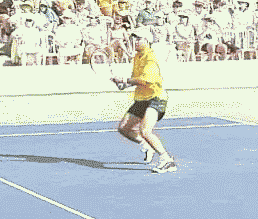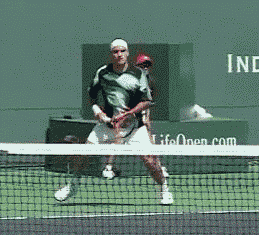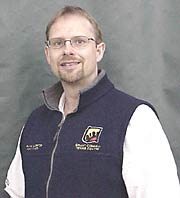|
TennisOne Lessons
The Footwork Challenge Game-Based Situation Training Wayne Elderton I am going to take a little detour from my Situation training series to answer a call Jim McLennan put out to the contributors to TennisOne. He asked for our take on footwork. So, here are some of the keys I have found to improve players. Actually, I've always connected positioning with footwork to round out the whole package of movement elements in tennis. Footwork and positioning are something every player and coach recognizes as critical. Footwork is the ‘technique' of moving, the how and when of which foot goes where. Positioning is the ‘tactic' of moving, where you locate on the court and why. Although I usually connect them together, to save space, I will limit this article to footwork considerations only. Interrelated Elements Important as it is, players and coaches need to remember that footwork doesn't happen in a vacuum. Why footwork is difficult to master is its connection to other elements. The primary ones being:
Let's take a peek at each of these:
Impact Point The purpose of footwork is to maneuver in a way that creates the best relationship between you and the ball. A good impact point is the goal of all footwork. One can do many exercises and drills to improve the movements of footwork (and we will see some in this article), but ultimately, the proof is in the hitting. Rotation Strongly related to the impact is the ability to use rotational force. In simple terms, you hit more effectively and with less effort when you rotate. There are very few shots in tennis that cannot be improved with better rotation. Take a look at volley master Pat Rafter's above and see that, even on a volley, the body rotates. In the ‘loading' phase, Rafter turns so his back is 45 degrees to the service line. He rotates through until his front is turned 45 degrees the other way. It may not look like much but, grab a racquet and try it and you will feel how substantial it really is. Balance Rotation can be implemented only if a player creates a balanced axis to rotate around. Imagine a line running vertically from a player's head, through their center of gravity, to the ground. This is their “line of gravity.” On groundstrokes and volleys, the straighter the line (no bending at the waist or tipping of the shoulders), the better the axis to rotate around. This principle is true whether a player is in motion (dynamic balance) or relatively still (static balance). There will be a slight lean in the direction a player is moving, however, the line will basically look straight to an observer and feel straight by the player. I would recommend Feisal Hassan's articles on balance in the TennisOne Lesson Library as a starting point toward improving footwork.
So what do impact, rotation, and balance have to do with footwork? Everything! Footwork allows for (or hinders) all these elements. Footwork training that doesn't improve these elements ends up being running for no purpose. Having a coach send you to all corners of the court and yell, “run faster!” doesn't necessarily develop any of these elements well. It is my opinion that the ‘grace' and ‘fluidity' of movement we see in top players are these things in action. Of most importance is the relationship between the player's head, and their center of gravity (COG). If a player keeps his head and COG more or less in line, all things are possible. Look at the ‘master of movement', Roger Federer (left). After the hit, despite the forces created by his movement that work to throw him off balance, he quickly snaps the line back into place to recover. That line of gravity is key, regardless of where his legs are. It is the re-establishment of balance that sets pros apart from the rest of us even more than their movement to the ball. We can all muster looking graceful for a single shot. To be fluid on multiple shots, however, requires this expert recovery. When a player's head starts to get away from the line of gravity they begin to appear ungraceful and jerky. Footwork Exercise for Groundstrokes One of the most powerful non-hitting footwork exercises I know involves a medicine ball. The great advantage of a medicine ball is that it encourages balance, rotation, and coordination of all the links in the body. This would be defined as a “functional exercise” (see Donald Chu's article on TennisOne) since it re-creates the real movements of tennis.
A medicine ball never lies. If you coordinate well, the ball goes harder and further, coordinate poorly and you can't propel it with any force. Be warned! This exercise will really expose weaknesses in your movement! Medicine Ball Exercise For adults or juniors over 14, use a 3 kg (approx. 6 lbs) ball. The exercise should be done with lateral movement (going wide for forehands and backhands) as well as movement up and back (mimicking going after short balls and deep balls). Start with the ball at your center of gravity (hip level). Run wide, plant (hint: open stance works better), and throw the ball like you were rotating through a stroke. For two-handers, the exercise is the same on both sides. For players with a one handed backhand, use a smaller 1 kg (2 pound) ball. The prescription is this: Do 8 reps (4 forehands, 4 backhands). Send a ‘line drive' trajectory with force to your partner (no ‘bloop balls'). Then, take your racquet and have a friend (or ball machine) send you 8 balls from side to side that you hit. Most players are very pleased with the first few shots. The goal is to reproduce the same movements and feelings you had with the medicine ball. Doing 8 reps with the ball and 8 with the racquet is one ‘set'. Do 3 sets, rest 2 minutes, repeat this 3 times. If you continue doing this 2-3 times per week for 3 months, you will notice substantial results.
The main point to look for is keeping a good line of gravity though the whole movement (keep your head above your hips). This is also indirect resistance training. It will strengthen legs, trunk, and shoulders. It will make your movement without the medicine ball seem easier. How does Footwork Training fit into Situation Training? Even though I have taken this detour, the fact is, footwork is also part of Game-based Situation Training (see my previous articles in the TennisOne Lesson Library). Each situation has unique footwork challenges. The exercises outlined above are the preliminary work so your body can access these movements to create the principles mentioned at the beginning (good impact point, balance, rotation). To integrate any footwork training regimen into your game, make sure you practice in the specific situations you encounter when you play. Each situation goes through a “Footwork Cycle” which includes:
This cycle fits into the Shot Situation cycle I outlined in my last article. The elements outlined in this article are not the only things that are important to ensure proper footwork. They are just some of the ones I have found, that when mastered, make a big impact on your tennis movement. Your comments are welcome. Let us know what you think about Wayne Elderton's article by emailing us here at TennisOne.
|



 Wayne Elderton
Wayne Elderton